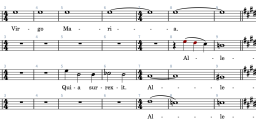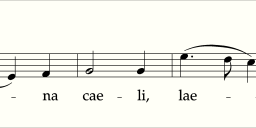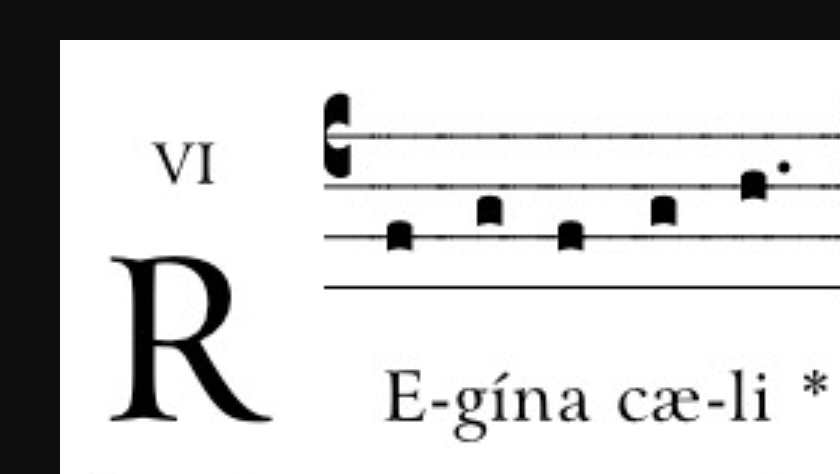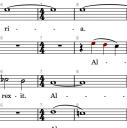Choral Regina Caeli - New Work
-
UPDATED - Recording with actual singers: https://adammichaelwood.s3-us-west-1.amazonaws.com/regina-caeli-vocal-rough.mp3
Also - ignore that stuff with the antiphon.
---
Free to use.
Constructive opinions welcome.
PDF: https://s3-us-west-1.amazonaws.com/adammichaelwood/regina-caeli-adam-michael-wood.pdf
Audio simulation: https://s3-us-west-1.amazonaws.com/adammichaelwood/regina-caeli.mp3 -
Adam,
Thank you for composing it. It has brightened my day.
Thanked by 1Adam Wood -
Do you mean it to sound as if it were the celebration scene at the end of The Scarlet and the Black?
-
I NEED AN OPINION
I've composed the versicle.
Thoughts?
(ignore the time signatures)

 Screen Shot 2020-01-17 at 1.31.55 PM.png2394 x 628 - 157K
Screen Shot 2020-01-17 at 1.31.55 PM.png2394 x 628 - 157K -
OH ALSO, you should totally program this for Easter
-
m. 7 to the end - consider switching alto and tenor.Thanked by 1Adam Wood
-
> switching alto and tenor
i definitely agree with this.
---
BUT
okay so i guess my big question here is:
Is the key change just here at the end cheesy and on the nose, or is it - as i am hoping - a beautiful musical expression of Christ's rising, and a fitting end to the piece? -
EASTER IS COMING
-
Adam,
I haven't looked at in tremendously great detail, but it seems that the key change is gratuituous --- what you called "cheesy and on the nose". Mind you, the vertical presentation before the key change is jarring to my ear. Is this intentional?
-
It was just an idea that I thought was interesting at the time. I like it less now.
-
Programming it for Eastertide this year---perhaps at May Crowning Mass.
Also, is it possible to extract the Alleluia (quoting the [in]famous mode vi Antiphon) for use as the Communion Antiphon (or, rather, in my place, the Vespers Antiphon) at the Easter Vigil?Thanked by 1Adam Wood -
Extract away!
If you write or freshly arrange a tone for verses, please post it. -
Oh - and if there is any way you could make a recording of the whole piece, I would very much appreciate it.
-
On a piano in the lobby of building 1900 at the Googleplex, in the middle of the night.
-
The versicle is missing some words: "Quia surrexit Dominus vere, alleluia"
-
This is true. Though I believe what I included is a complete and correct utterance in Latin.
(Not that it matters, I don't think I like it.) -
Am I mistaken or are you proposing an Eb in the upper part and a prolonged E natural in the bass line?
-
UPDATED:
Here is a recording with actual singers.
https://adammichaelwood.s3-us-west-1.amazonaws.com/regina-caeli-vocal-rough.mp3
Also, ignore the antiphon stuff in the above comments. -
The problem with the whole is found in the first two bars. Saying "relaxed" does not allow the composer to forgo being accurate and careful with the rhythm. When the voice parts differ, sometimes a decision is necessary: which voice part will the listener follow? Ignoring bar lines, just look at the soprano: is it really possible to sing re-gi-na-cael- LIIIIIIIIII! If you have the time and interest, perhaps starting with only one voice could work -- establish what you intend to do with the rhythm .. then be clear, when and if another voice contradicts the established agreement, let it be dramatic.
Thanked by 1Adam Wood -
something like this might work -- I'd want, given the alleluia following, TWO alleluias to give a balanced beginning!

 adam1.png3635 x 868 - 26KThanked by 1Adam Wood
adam1.png3635 x 868 - 26KThanked by 1Adam Wood -
I don't understand the basis of that critique - are you saying the verbal rhythm should be perfectly homophonic throughout?Thanked by 1Adam Wood
-
Not at all -- but that the individual part must be 'perfect' and the whole must be understandable.
-
@mrcopper I deeply appreciate your engagement with the work.
I do think I disagree with you here, though.
As to your question
> which voice part will the listener follow?
My intention was the soprano, throughout.
I described the intention to the performers as:
> This is essentially a solo chant, with a choral accompaniment.
As this was remotely recorded with two singers, I had the female singer sing the soprano line first, directing her to sing it (more or less) freely, and then has the other parts recorded (Bass first, then ten, then alto), fitting their performance to the "solo" soprano line.
Two things I think might be militating against this intention:
- the text setting, which perhaps I should have kept homophonic throughout
- the sound mix on the above-posted track -
Oh, also - did you like, generally?
-
is it really possible to sing re-gi-na-cael- LIIIIIIIIII!
This is a direct quote:

 Screen Shot 2020-08-06 at 9.59.23 AM.png840 x 474 - 96K
Screen Shot 2020-08-06 at 9.59.23 AM.png840 x 474 - 96K -
Well, bar lines do change things. In the recording, the soprano's "LI" fades away and the bass "NA" marks the bar ..
Do you think the accented "GI" of "Regina" in your chant excerpt indicates a rhythmic accent, or a vowel pronunciation? In modern terms, it would look like a 3 4 bar with the second note as the second scale step and an unaccented neighbor, followed by another 3 4 bar with the "LI" of "Caeli" as an unaccented harmony tone with the "CAE" the accented appoggiatura. That interpretation supports the dot on the note .. but does not support a rhythmic accent.
I'm not ignoring your question "do you like it?" but that's always a difficult question to answer .. I like bits of the melody and don't like that the setting seems sometimes to detract from the beauty of moments of melody or note combinations. -
the bar lines are for organizational purposes only, so a choir doesn't get lost (and so conductors without chant experience can conduct).
the piece does not have a time signature, and should not be sung as if "downbeats" of measures are accented. -
again I appreciate your engagement with my work, but I wonder if your contemporary-music context makes it difficult to get what I'm going for with the chant rhythm.
honestly, I think I was successful (more or less) on what I was trying to do, and where I think I could use the most help/development as a composer is the harmony, and so would appreciate critique/advice on that aspect in particular. It is my weakest skill, and what I was attempting in this piece was really on the edge of what I am capable of. -
so, i am still unclear... the upper voice has an e flat and the lower voice has an e natural, but that is not what is in the recording...????

 Screen Shot 2020-08-07 at 5.46.41 PM.jpg543 x 549 - 56K
Screen Shot 2020-08-07 at 5.46.41 PM.jpg543 x 549 - 56K -
About the barring: Where the difficulty seems to be is with the first two bars, after that you seem to be barring based on the musical-textual accents of the Soprano, but in the first two bars you go against the bar. I would suggest altering the barring there to match the rest of the piece, which will make the accents line up. Also, have you considered using Mensurstriche as is sometimes used in early music? This might also be a graphical solution.
-
Mensurstriche has never sat right with me. Hugo Distler's approach to this sort of notation might work better, Adam. If you're not familiar with his works, I can send them privately (still under copyright in the US, I believe)
-
> the upper voice has an e flat and the lower voice has an e natural,
That bit is not part of the composition any more.
> Where the difficulty seems to be is with the first two bars
I think part of the difficulty here is that I originally wrote this harmonization with an English adaptation, which was *close enough* that it convinced me this was fine. But the accent was slightly different:
"O Quee--en of Heav'n" - pushing the accent to the last beat (where "-li" is)
However: even that was a concession because I originally had:
O Queen of Heav-en
which - IN THEORY - has the same accent pattern as "Regina Caeli", BUT
doesn't work with the original chant because, without bars or etc,
the tune itself puts a "li" on an strong accent,
but you don't notice it because:
- chant frequently subverts textual accents in order to even out the line
- many flavors of chant performance practice try to have no accents at all
- you're not trying to critique
So: in my opinion, the rhythm/accent I have above is essentially a direct quote from the chant. The recording above is how I intend it to sound, but that was communicated to the performers not just through the score but also in conversation and rehearsal. So, the relevant question is: would re-barring or otherwise changing the score make the intention more clear?
> Mensurstriche
I thought about this approach, as the "barlines don't actually matter" was kind of what I wanted. But I thought it would just make things more confusing for the people most likely to sing this (amateur church choirs).
> Hugo Distler's approach to this sort of notation might work better, Adam. If you're not familiar with his works,
Very curious, please.
Also, i did a quick Google search and I think now I'm going to say him when people ask me who my celebrity look-alike is. (I wish I was as skinny as he is, but it's the current year, so whatever)
---
Still curious if anyone has thoughts, critiques, or advice about the harmony/counterpoint. And the actual way the piece sounds.
Welcome to the MusicaSacra Forum!
To participate in the discussions on Catholic church music, sign in or register as a forum member, The forum is a project of the Church Music Association of America.
Categories
- All Discussions21,108
- General Music Discussion8,218
- Job Openings197
- Management of Music Programs850
- Choral Matters533
- Church Documents and Rubrics524
- CMAA Notes302
- Events716
- For Newcomers: Read First26
- Sacred Polyphony546
- Hymnody872
- Gregorian Chant: General2,698
- ↳ Graduale Romanum and Liber Usualis368
- ↳ Graduale Simplex60
- ↳ Semiology63
- Vernacular Plainsong696
- Anglican Use and Anglican Chant68
- Organ, Other Instruments and Repertoire435
- New Composition/Works in Progress1,291
- Recordings231
- Music for Hispanic Ministry159
- Music Education: Children211
- Music Education: General222
- News Items245
- Positions Wanted2
- General Discussion: Catholicism739
- Amusements177
- General Discussion1,033
- Opinions117





